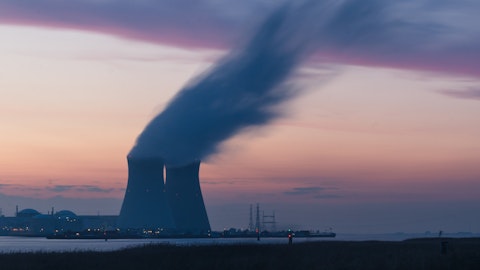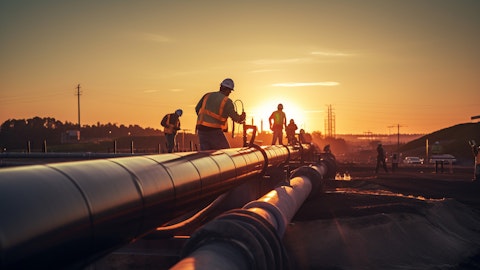Robert Kwan: Okay. If I could just shift to Cedar, you listed a number of things that you’ve got to work through. One of them that you didn’t list though is just around costs. So coming out of the field study, you’re comfortable with where those costs are; how you’re going to manage the risk, and it really is now how do you deal with a commercial on the other side. I guess, specifically on costs; can you just talk about how you are planning on managing cost overrun risk? And specifically, you’ve talked about fixed price EPCs [ph] but how are you planning on protecting yourself against the material type of overruns that we’ve seen in other projects that have led to contractor bankruptcies?
Cameron Goldade: Rob, I’ll start there and Stuart, feel free to jump in. But again, part of the timing around this project was ensuring that we had a very robust EPC contract lump sum turnkey; again, this is a ship being built in Korea in Samsung’s shipyard under a controlled environment with LNG modules being placed on top of it. And that is all under a lump sum turnkey arrangement, which is — the vast majority of the cost, which — again, we’ll lay this all out if you’re fortunate enough to make an FID decision. So I’m not trying to be coy, there’s just a lot of moving pieces; but on that piece we feel very, very comfortable given the robustness of the contract that we negotiated. The vast majority of that price has been pushed off onto our EPC contract, the remaining con — price that’s on risk for Pembina is pipeline and transmission lines.
And you know, it’s a 9 kilometer pipeline, 10 kilometer pipeline; I think given our track record, I would hope that market has some confidence around our ability to deliver on that. I mean, you just saw Phase VIII come in materially under budget; so we feel confident around doing our core business on this asset. And then of course, on top of that we have typical project contingency and protection. So overall, we feel good mainly because of — we went with a lump sum engineering contract, and those always cost a little bit more; but from a risk reward basis, we like that approach to major projects.
Robert Kwan: I’ll just finish a quick one here just on the Alliance; Aux Sable deal. You’ve got a HSR but can you just comment on where you are on the Canadian Competition Bureau approval?
Cameron Goldade: Yes, Rob. I would say that timing wise, you can see that we reiterated our second half — our first half of 2024 timeframe. You’re correct, we’ve got the waiting period expiry on HSR and Transport Canada. I would say we don’t have any better information at this point on the Competition Bureau process to refine that view anymore. Things are progressing as expected, as planned, but no sort of further visibility at this point to try and narrow that date.
Robert Kwan: Okay. Thank you.
Operator: Thank you. And your next question comes from the line of Zack [ph] from TPH. Your line is open.
Unidentified Analyst: Just one question. Just going to the [indiscernible] markets; it seems like a lot of those facilities are running close to full. I was just curious if you guys had any incremental room to capture spot rates moved up? And then, as you talk to producers, are frac constraints becoming more and more of a concern?
Jaret Sprott: Yes, good morning. Jaret here. The answer to your question is, yes. But we — it is becoming a concern for our customers but it’s also — we don’t have a lot of opportunity, unfortunately, because we’re fully contracted for the most part. We don’t have a lot of opportunity to get a lot of spot rates. The NGL season does start on April 1; so the teams are obviously in deep negotiations with respect to annual deals. But the majority of our contracts that are fractionation complex are long term in nature, you know, 5 to 10 plus years. So, unfortunately where we can grab those opportunities we do, but it is long-term in nature.
Scott Burrows: But certainly frac — future frac negotiations continue to progress. And with RFS being the next frac in service; RFS IV being the next frac in service — you know, we have the option to continue to progress those negotiations and sign up incremental barrels that’s predicted to come online in the first half of 2026. And is really the next material frac expansion that we’re aware of; and so those discussions continue.
Unidentified Analyst: Okay, perfect. That’s super helpful. And then, one on Cochin. It seems like Cochin and [indiscernible] saw oversubscribed shipper interest. I was curious if you could squeeze any more capacity out of that system with smaller capital efficient solutions or maybe there is a bigger project you guys could do as well?
Jaret Sprott: I’ll take that again. So Cochin, since we’ve acquired that asset in December of 2019, we’ve increased the throughput by roughly — I think 25% to 30%, and safely. So, I would say that we’re meeting all of customer demand today, our availability is extremely high; but I don’t think there’s — without a major expansion, there’s not a lot of room unfortunately left on that asset.
Unidentified Analyst: Okay, perfect. Super helpful as well. That’s all I had for today. Thanks, guys.
Operator: Thank you. And your next question comes from the line of Patrick Kenny from National Bank Financial. Your line is open.
Patrick Kenny: Yes, good morning guys. Just on the Wapadi [ph] expansion, nice to see the commercial support there. I am wondering if you could just update us on what other GNP [ph] expansion opportunities might be in the queue across your portfolio based on the customer activity levels that you’re seeing in the field these days?




